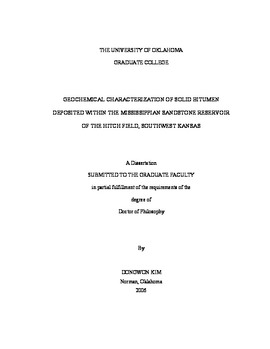| dc.contributor.advisor | Philp, Richard P., | en_US |
| dc.contributor.author | Kim, Dongwon. | en_US |
| dc.date.accessioned | 2013-08-16T12:20:21Z | |
| dc.date.available | 2013-08-16T12:20:21Z | |
| dc.date.issued | 2006 | en_US |
| dc.identifier.uri | https://hdl.handle.net/11244/1077 | |
| dc.description.abstract | The occurrence of solid bitumen in petroleum reservoirs is a common phenomenon in many petroliferous basins worldwide. Solid bitumen was recently identified within the Upper Mississippian (Chesterian) sandstone reservoir in the Hitch field, southwest Kansas. The occurrence of solid bitumen was unexpected since the Anadarko Basin and its shelf areas have been known for the production of gas and light oil. Solid bitumen containing significant volumes of immovable and highly viscous organic materials may cause a major economic problem closely related to the deposition of paraffin waxes and asphaltenes in a reservoir. The presence of solid bitumen will in turn result in a disappointing production performance and requiring additional production costs to remedy formation damage. The presence of solid bitumen impacts oil production economics by forming barriers in the reservoir, which prevent crude oils from flowing during production. | en_US |
| dc.description.abstract | Several processes leading to the deposition of solid bitumen (i.e. tar-mat formation, asphaltene precipitation) in a reservoir have been proposed in the literature. Natural processes include gas deasphalting, biodegradation, low reservoir temperature, in-reservoir oil mixing, pressure reduction during reservoir inversion, and thermal cracking at an elevated reservoir temperature. Solid bitumen can also be formed by production operations such as water-flooding and CO2 injection for an enhanced oil recovery. Geochemical evidence suggests that biodegradation and thermal alteration are not responsible for the formation of solid bitumen in the Hitch field. The deposition of solid bitumen in the Hitch reservoir appears to be explained by the mixing of oils with different geochemical compositions, especially the addition of gaseous components and paraffinic crude oils to asphaltene-rich oils, from multiple source rocks filling the reservoir over an extended period of time. A possible reservoir filling scenario revealed that the Hitch field oils are more heterogeneous in geochemical composition than the Etzold field oils due to multiple sources. Furthermore, gas deasphalting and regional pressure and temperature drops as a result of post-Laramide orogeny may have contributed to a phase change in the reservoir fluid to precipitate solid materials by disturbance of thermodynamic equilibrium. (Abstract shortened by UMI.) | en_US |
| dc.description.abstract | A comparable study of crude oils and source rocks in the Anadarko Basin was undertaken in an attempt to relate the oils to their possible source rocks. Based on their biomarker distributions and carbon isotopic compositions, it was concluded that the Hitch and Etzold crude oils are mixtures of hydrocarbons derived from Ordovician and Devonian (Woodford Shale) source rocks. | en_US |
| dc.format.extent | xxv, 266 leaves : | en_US |
| dc.subject | Geology. | en_US |
| dc.subject | Geochemistry. | en_US |
| dc.subject | Oil fields Production methods Kansas. | en_US |
| dc.subject | Bitumen Kansas. | en_US |
| dc.title | Geochemical characterization of solid bitumen deposited within the Mississippian sandstone reservoir of the Hitch Field, southwest Kansas. | en_US |
| dc.type | Thesis | en_US |
| dc.thesis.degree | Ph.D. | en_US |
| dc.thesis.degreeDiscipline | Conoco Phillips School of Geology and Geophysics | en_US |
| dc.note | Adviser: Richard P. Philp. | en_US |
| dc.note | Source: Dissertation Abstracts International, Volume: 67-06, Section: B, page: 3015. | en_US |
| ou.identifier | (UMI)AAI3222156 | en_US |
| ou.group | Mewbourne College of Earth and Energy::Conoco Phillips School of Geology and Geophysics | |
